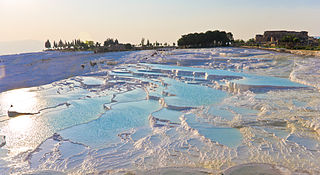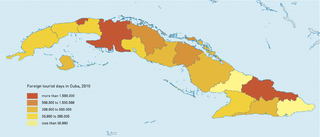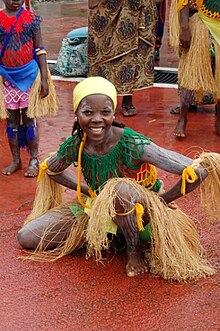
Tourism is travel for pleasure, and the commercial activity of providing and supporting such travel. UN Tourism defines tourism more generally, in terms which go "beyond the common perception of tourism as being limited to holiday activity only", as people "travelling to and staying in places outside their usual environment for not more than one consecutive year for leisure and not less than 24 hours, business and other purposes". Tourism can be domestic or international, and international tourism has both incoming and outgoing implications on a country's balance of payments.

Tourism in Australia is an important part of the Australian economy, and comprises domestic and international visitors. Australia is the fortieth most visited country in the world according to the World Tourism Organization. In the financial year 2018/19, tourism was Australia's fourth-largest export and over the previous decade was growing faster than national GDP growth. At the time it represented 3.1% of Australia's GDP contributing A$60.8 billion to the national economy.

Guanacaste is a province of Costa Rica located in the northwestern region of the country, along the coast of the Pacific Ocean. It is bordered by Nicaragua to the north, Alajuela Province to the east, and Puntarenas Province to the southeast. It is the most sparsely populated of all the provinces of Costa Rica. The province covers an area of 10,141 square kilometres (3,915 sq mi) and as of 2010, had a population of 354,154, with annual revenue of $2 billion.

Tourism in New Zealand comprised an important sector of the national economy – tourism directly contributed NZ$16.2 billion of the country's GDP in the year ended March 2019. As of 2016 tourism supported 188,000 full-time-equivalent jobs. The flow-on effects of tourism indirectly contributed a further 4.3% of GDP. Despite the country's geographical isolation, spending by international tourists accounted for 17.1% of New Zealand's export earnings. International and domestic tourism contributed, in total, NZ$34 billion to New Zealand's economy every year as of 2017.

Tourism in Indonesia is an important component of the Indonesian economy as well as a significant source of its foreign exchange revenues. Indonesia was ranked at 20th in the world tourist Industry in 2017, also ranked as the ninth-fastest growing tourist sector in the world, the third-fastest growing in Asia and fastest-growing in Southeast Asia. In 2018, Denpasar, Jakarta and Batam are among of 10 cities in the world with fastest growth in tourism, 32.7, 29.2 and 23.3 percent respectively. The tourism sector ranked as the 4th largest among goods and services export sectors.

Sri Lanka is a popular tourist destination. Tourism is a key industry that attracts international tourists yearly. Foreigners visit Sri Lanka to see nature, wildlife, historical monuments, and indigenous culture. In 2018, tourist arrivals peaked at 2.5 million, who spent a total of US$5.6 billion in the country. However, the COVID-19 pandemic caused tourist numbers to decrease by 92% in 2020. As of 2022, tourist numbers have not rebounded from the pre-crisis high. The government is attempting to attract foreign investment in the country's tourism industry, which began in earnest after the end of the Sri Lankan Civil War in 2009.

Tourism in Turkey is focused largely on a variety of historical sites, and on seaside resorts along its Aegean and Mediterranean Sea coasts. Turkey has also become a popular destination for culture, spa, and health care. Since 2021, Turkey is the fourth most visited country in the world.

Arugam Bay, known locally as "Arugam Kudah", is situated on the Indian Ocean in the dry zone of Sri Lanka's southeast coast, and a historic settlement of the ancient Batticaloa Territory. Arugam Kudah's literal Tamil translation is "Bay of Cynodon dactylon".

Tourism in Cuba is an industry that generates over 4.7 million arrivals as of 2018, and is one of the main sources of revenue for the island. With its favorable climate, beaches, colonial architecture and distinct cultural history, Cuba has long been an attractive destination for tourists. "Cuba treasures 253 protected areas, 257 national monuments, 7 UNESCO World Heritage Sites, 7 Natural Biosphere Reserves and 13 Fauna Refuge among other non-tourist zones."

Tourism in Wales makes up a significant portion of the Welsh economy and attracting millions of visitors each year. The tourism industry in Wales was worth around £5bn in 2017. The tourism industry also makes a significant contribution to the Welsh economy, supporting over 100,000 jobs and more than 8% of the Welsh workforce. Wales attracts visitors from overseas, particularly from the United States, Australia, Germany and the Republic of Ireland.
In the study of tourism, the leakage is the way in which revenue generated by tourism is lost to other countries' economies. Leakage may be so significant in some developing countries that it partially neutralizes the money generated by tourism.

Tourism in Cyprus occupies a dominant position in the country's economy, and has significantly impacted its culture and multicultural development throughout the years. In 2006, the tourism industry made up 10.7% of the country's GDP and the total employment in the tourism industry was estimated at 113,000 jobs. With a usual minimum of around 4 million tourist arrivals per year, it is the 40th most popular destination in the world and the 6th most popular per capita of local population. Cyprus has been a full member of the World Tourism Organization since 1975.

Tourism in Nicaragua has grown considerably recently, and it is now the second largest industry in the nation. Nicaraguan President Daniel Ortega has stated his intention to use tourism to combat poverty throughout the country.

Since the 2000s, Tourism in Peru has made up the nation's third largest industry, behind fishing and mining. Tourism is directed towards archaeological monuments, ecotourism in the Peruvian Amazon, cultural tourism in colonial cities, gastronomic tourism, adventure tourism, and beach tourism. Iperú is the Peruvian national tourist office.

Tourism in Malta is an important sector of the country's economy, contributing to about 15 percent of the nation's gross domestic product (GDP). It is overseen by the Malta Tourism Authority, in turn falls under the responsibility of the Minister for Tourism, the Environment and Culture. Malta features a number of tourism attractions encompassing elements of the island's rich history and culture, as well as aquatic activities associated with the Mediterranean Sea. In addition, medical tourism has become popular in Malta in recent years, especially since government efforts to market the practice to medical tourists in the United Kingdom.

Tourism is an important economic sector for many countries in Africa. There are many countries that benefit heavily from tourism like Kenya, Uganda, Algeria, Egypt, South Africa, Morocco, Tunisia, Ghana and Tanzania. The touristic particularity of Africa lies in the wide variety of points of interest, diversity and multitudes of landscapes as well as the rich cultural heritage. Also, an ecotourist industry is present in some African countries.

Visitors to Liberia must obtain a visa from one of the Liberian diplomatic missions unless they come from one of the visa exempt countries. Yellow fever vaccination is required.

Tourism accounts for a large part of El Salvador's economy. El Salvador has many natural attractions including beaches with some of the best surfing breaks on the Pacific Coast. El Salvador offers many lush forests shrouded in cool temperatures with abundant wildlife and scenic mountain-top vistas. El Salvador also has great potential in the field of cultural tourism; with over 2,000 known archaeological sites, mostly of the Maya and Olmec cultures. These sites are of international interest for their easy access and well-preserved remains.

International tourism is tourism that crosses national borders. Globalisation has made tourism a popular global leisure activity. The World Tourism Organization defines tourists as people "traveling to and staying in places outside their usual environment for not more than one consecutive year for leisure, business and other purposes". The World Health Organization (WHO) estimates that up to 500,000 people are in flight at any one time.
Prostitution in the Gambia is widespread but illegal. Most of the estimated 3,100 prostitutes in the Gambia are from Sierra Leone, Liberia, and Guinea. Prostitution takes place on the beach, in bars and hotels on the coast. Away from the coast, prostitution mainly takes place in bars. The bars are frequently raided and the foreign prostitutes deported. They often return within a few days.


















